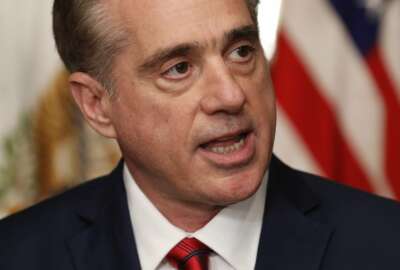
VA wants to make telehealth part of its day-to-day business, but says state licensing laws stand in the way
VA says it wants to significantly expand the health care services it offers through telehealth technologies — voice, video, instantaneous record-sharing — but...
The Veterans Affairs Department has an ambitious long-term outlook for how it might dramatically expand the medical services it delivers to veterans through telehealth. As of now though, many of those plans are technically illegal because of state-by-state medical licensing requirements, and the department says that needs to change.
VA is already regarded as a national leader in telemedicine. It spent $1.2 billion last year, up from $500 million in 2013, for a total of 2 million clinical encounters between veterans whose doctors were at distant locations. Overall, about 12 percent of the Veterans Health Administration’s enrolled patients got at least some portion of their treatment through telehealth.
But the department says it wants to do a lot more.
Most of its current services connect a doctor at one VA facility with a patient at another one. That’s perfectly legal, as long as the doctor has an unrestricted license in at least one state. But the rules are different if the patient is not on federal property — say, at his or her home, or at a private-sector medical clinic. In that case, the VA clinician would have to be licensed in the state where the patient happens to be sitting.
“Legislation is really critical to realize our vision,” Dr. Kevin Galpin, the executive director of telehealth services in the Veterans Health Administration, told the Senate Appropriations Committee. “We really need to be authorized to deliver care to a veteran in any location: libraries, post offices or academic sites, or any private site where a veteran can come for care.”
Specifically, VA wants Congress to invoke the Constitution’s supremacy clause to override state licensing laws, making clear that, at least in the case of VA, doctors don’t need to be licensed in the same state where they’re practicing.
The department says the change would have major implications for how the VA runs its medical system at the local, regional and national levels, but perhaps the biggest impact would be in smaller, more rural communities where veterans need specialized care that’s not available through private providers, or where it’s very hard for VA to recruit its own medical staff. The department has about 45,000 vacancies, most of them in health care operations.
“What we have in this country is there are certain places where there are just gaps in services,” Galpin said. “We need to look and say, ‘Where can’t you get a certain service in the VA? Where, for example, can’t you get neurology care, and where is that care also not available in the community?’ That’s on the top of our work list. We need to figure out a program so we can remote-in that care or do a hybrid model where we bring in some in-person and some remote care. And at our rural sites, if you lose one of your primary care providers, we don’t want to wait six months to a year to get someone else in there.”
The department says it is not looking to replace face-to-face contact with medical providers. The decision to use telehealth is ultimately up to the patient, and whether it works at all is highly dependent on the type of care the patient needs.
But in some cases it would, for example, let snowbird patients, who spend part of the year in one area of the country and several months in another, see the same doctor for all of their visits, if that’s the patient’s preference.
Galpin said it would also let VA make better use of its specialists who are experts in medical conditions that are more common to veterans than the general population.
“If there’s a national expert in a rare condition at one of our academic sites — let’s say there’s 10 veterans in the country that have that rare condition — that provider is providing input into all of their care,” he said. “We’re already trying to move to a model where we’re doing more interstate, more across the [Veterans Integrated Services Network], but where we expect to go is to leverage the VA enterprise in a way that you can’t do if you don’t have a national integrated health care system. And I think that’s where it starts getting incredibly exciting.
Relaxing current rules would also help VA partner with other medical providers and extend care to veterans the department simply isn’t reaching today, said Michael Adcock, the executive director at the center for telehealth at the University of Mississippi Medical Center.
In his state, Adcock said VA’s two hospitals and eight clinics are only used by about a third of Mississippi’s eligible veterans, partly because those that do face long wait times to get appointments. That could change if VA and the university medical system could partner to treat veterans at brick-and-mortar facilities that the university has already networked together.
Latest Veterans Affairs News
“By layering veterans services across our 200 active telehealth access points, the VA could quickly reach more patients without significant investment,” he said. “Because of the deep nexus that already exists between academic medical centers and the nation’s VA hospitals, it seems a natural progression for us to partner to provide health care and chronic disease management for our veterans. We’ve attempted this type of partnership in the past, but were unsuccessful due to administrative red tape and the VA’s challenges in engaging with external health care partners. After multiple attempts to bring requested dermatology and mental health services to the VA, progress stalled and the services were not implemented.”
Even without new legislation, the department sees several ways in which it can continue to make more and better use of telehealth. As of now, most of VA’s telemedicine programs are administered by local facilities that usually don’t face the problem of treating patients across state lines, and those programs can certainly expand.
“Telehealth is just going to be integrated into our daily operations,” Galpin said. “Probably every specialty is going to adopt some portion of remote care or virtual care to make their services more accessible. It’s just going to be a part of routine operations. When a veteran leaves a clinic appointment, there’s going to be the question, ‘How do we best deliver the next visit? Is it in-person? Is it by telephone? Is it by video? So it’s just going to be kind of part of the regular routine and thought processes.”
VA thinks telemedicine has important near-term implications for critical, acute health care issues. The department is piloting a “tele-stroke” program at 10 of its sites over the next five years, making it a priority, because stroke victims often need the right treatments within minutes in order to avoid permanent brain damage.
“We focus a lot on ambulatory care, but the in-patient potential for this is dramatic,” Galpin said. “You can use it to build a specialty consultant network so that you have a button on the wall in an intensive care unit and say, ‘I need to talk to an intensivist’ or ‘I need the neurologist right now.’ That’s critical, and that’s lifesaving.
Copyright © 2025 Federal News Network. All rights reserved. This website is not intended for users located within the European Economic Area.
Jared Serbu is deputy editor of Federal News Network and reports on the Defense Department’s contracting, legislative, workforce and IT issues.
Follow @jserbuWFED




